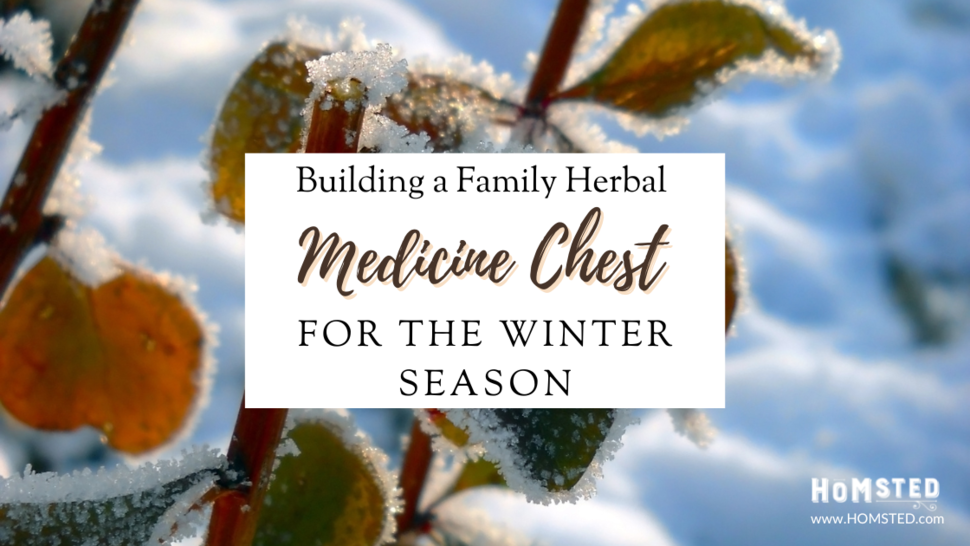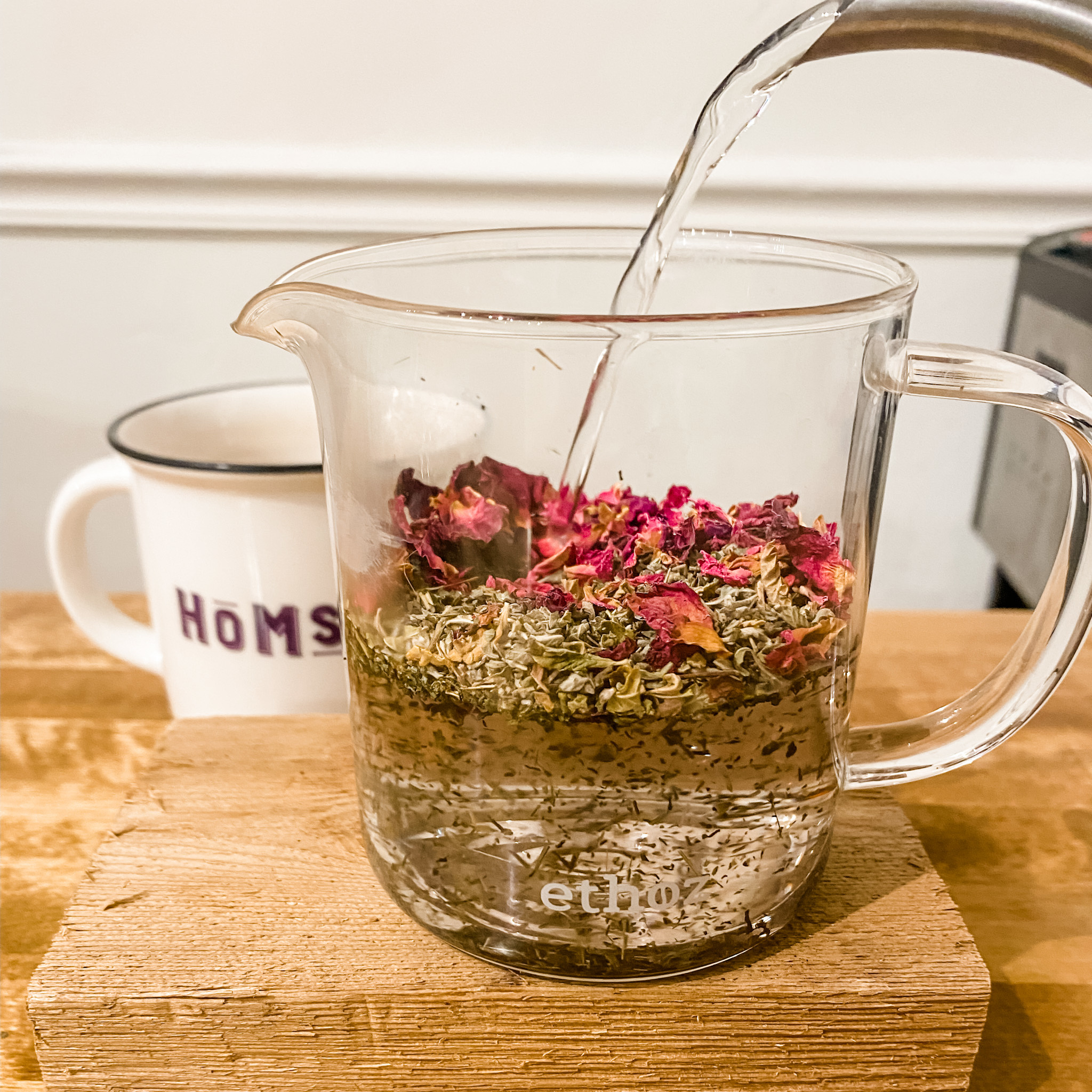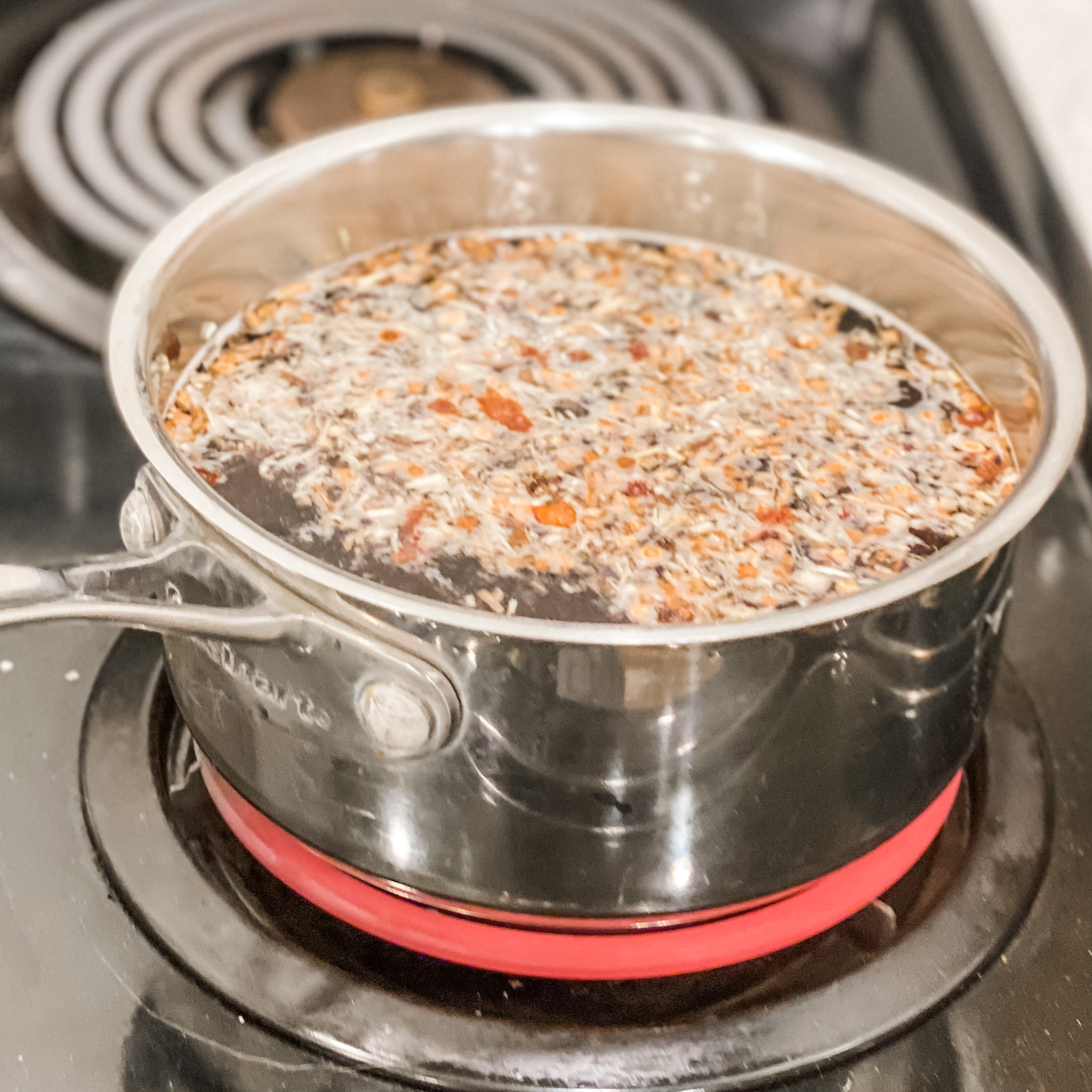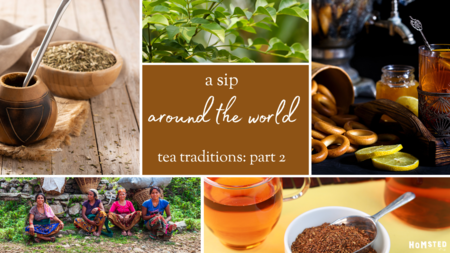Building a Family Herbal Medicine Chest For the Winter Season

The winter season usually offers no shortage of illness, especially for families. Our increased time indoors also increases transmission of pathogens. However, there is a multitude of herbal options for preventing and treating many of the infections that wintertime brings. From simple and quick teas, to potent tinctures and aromatic essential oils, DIY herbal options offer you a chance to take your families health into your own hands.
Herbal Teas
Herbal teas are a great way to use herbs at home. My children love taking them, especially when they pick it directly from the garden. Most herbs are very hardy and can last through the fall and into the early winter. For the less palatable herbs, a little added honey is an easy fix. Make some fun out of it and have a tea party with the whole family!
When brewing a medicinal tea there are two ways of doing it:
Infusions: are typically used with the softer parts of the plant such as leaves, flowers and aerial parts. Use one tablespoon of herb to one cup of water. Let steep 20 min to 24 hours depending on the plant, with the lid on.

Decoctions: Cells of roots, barks, berries and seeds are often quite a bit tougher. Because of this, simmering of the materials is often necessary to break down cell walls. Mushrooms, too, often require decocting to extract the polysaccharides. Use one tablespoon of herb to one cup of water. Let simmer for 20 min with the lid on.

Dosages:
Suggested tea dosages for children (when adult does is 1 cup):
Weight. Herb tea
Up to 5 lbs. 1 tablespoon
5-15 lbs. 2 tablespoon
16-35lbs. 1/4 cup
36-65 lbs. 1/2 cup
66-80 lbs. 3/4 cup
81-110 lbs. 1 cup (adult dose)
Tinctures
A tincture is a rather concentrated water/alcohol extraction of an herb. Since a tincture is in liquid form, the phytochemicals (plant chemicals) are immediately absorbed into the bloodstream and assimilated by the body.
Herbalist Tip: Capsules do not have this advantage as they must be broken down and assimilated.
One dropperful of tincture is equivalent to consuming 1/60th of an oz of alcohol or the amount of alcohol that is in a ripe banana; a very small amount. But if you want to remove the alcohol, add it to boiling water or herbal tea and let it sit a few minutes to remove about 60% of the alcohol. I have no problem giving the alcohol tinctures to my kids but I add the prescribed amount to a little bit of water or juice or add some honey or glycerine for a sweeter flavor.

Suggested tincture dosages for children (when adult dose is 1 teaspoon/ 60 drops):
Younger than 3 months: 2 drops
3 to 6 months: 3 drops
6 to 9 months: 4 drops
9 to 12 months: 5 drops
12 to 18 months: 7 drops
18 to 24 months: 8 drops
2 to 3 years: 10 drops
3 to 4 years: 12 drops
4 to 6 years: 15 drops
6 to 9 years: 24 drops
9 to 12 years: 30 drops

Dried herbs or tinctures I like to have on hand
Astragalus (Astragalus membranaceus)
Part used: root
Benefits: Adaptogenic (resistance building). It strengthens the deep immune system by helping rebuild the bone marrow reserve that regenerates the body’s protective shield.
Suggested uses: used best for long term illness, low energy and to build and support immunity. You can decoct for a tea, make a cold infusion, tincture, use in soup or you can just chew on root!
Catnip (Nepeta cataria)
Parts used: leaves, flowers
Benefits: My go-to for lowering fevers as it is a diaphoretic. It also is a great calming herb for all types of stress. It helps with the pain of teething. It also helps aid with indigestion and diarrhea.
Suggested uses: infusion or tincture.
Elderberry (Sambucus nigra)
Parts used: Berry
Benefits: A great preventative for cold and flu but helps relieve nasal and upper respiratory congestion.
Suggested uses: decoction or tincture

Ginger (Zingiber officinale)
Parts used: root
Benefits:Great for treating chills, fever, gas, nausea and congestion.
Suggested uses: Steep 1 to 2 teaspoons of fresh grated ginger root or dried root in 1 cup boiling water, covered for 10 min. Give 1/4 to 1 cup up to 4x daily.
Licorice (Glycyrrhiza glabra)
Parts used: root
Benefits: Use for bronchial congestion, sore throat, coughs, and inflammation in digestive tract (such as ulcers)
Suggested uses: use in syrups, mix in teas and my kids love crewing on stick!
Caution: Don’t use it if you have hypertension, kidney/bladder problems, or are on steroids.
Marshmallow (althaea officinalis)
Parts used: root
Benefits: soothing, mucilaginous herb. It can also help with ulcers or inflamed gut. It is one of the best for sore throats.
Suggested uses: make as a cold infusion (just use room temperature water)
Mullein (Verbascum thapsus)
Parts used: leaves and flowers
Benefits: an expectorant that helps clear mucus from lungs or throat.
Suggested uses: make as a hot infusion or heated with olive oil for ear drops
Wild Cherry (Prunus serotina)
Parts used: inner bark
Benefits: An expectorant herb best for calming most types of coughs.
Suggested uses: use in teas, syrups, and tinctures for coughs and colds.
Aromatherapy
Essential oils are the volatile substances extracted from various plants, most commonly through steam distillation. These aromatic oils act quickly to affect our physical and emotional states and are powerful healing allies for babies and kids. We typically recommend only using essential oils externally... especially for children.
Ways to use aromatherapy: mixed with a carrier oil, body sprays, compresses, creams, liniments, bath salt, salve, steam inhalation, massage oils, palm inhalation, nasal diffuser, diffuser.

Carrier Oils:
- Dilution is key! You will want to mix your essential oil into a carrier oil before applying to the skin.
- Apricot Kernel oil is suitable, even for those with nut allergies. It is full of vitamins and minerals.
- Sweet Almond oil is closest to baby's own oil and works well for those who are not sensitive to nut-derived carrier oils. Great to relieve dry skin.
- Jojoba oil is actually a liquid wax that has a long shelf life and is easily absorbed. It is nourishing to skin.
Essential oils dosage:
Dosages per 1 oz carrier oil:
Newborns: 1 drop
2-6 months: 1 drop
6-12 months: 1-3 drops
1-4 years: 1-5 drops
5-7 years: 3-6 drops
8-12+ years: 5-10 drops
Essential oils I like to have on hand:
Eucalyptus radiata (Eucalyptus radiata):
Note: Eucalyptus radiata is the only eucalyptus suitable for children. Use for bronchitis, coughs, colds, flu, fever, headaches, asthma, insect bites, rashes, acne
Ravensara (Ravensara aromatica):
Use for muscular pain, chicken pox, colds, flu, muscular pain, swollen lymph glands
Lavender (Lavandula angustifolia):
A calming oil that can be used for headaches, rashes, eczema and burns.
Recipes for common winter ailments
Cold and Flu:

Garlic has been used for centuries as a medicine. The constituents in garlic have been shown to boost the disease-fighting response of some types of white blood cells in the body when they encounter viruses, such as the viruses that cause the common cold or flu. My kids know when a cold comes on, out comes the garlic. To administer it, I finely chop up a couple cloves of garlic, add it to a jar where I will mash it up with the back of a spoon. I will then add some honey. Once I have my mixture I will spoon out about a teaspoon and add a tincture to that such as echinacea and/or a couple drops of goldenseal for the extra pesky virus. I give this to my children 3x a day during or after a meal (raw garlic on an empty stomach does not always feel great). This trick has gotten us back on our feet many times especially when traveling (I don't travel without these).
Along with the garlic honey, I usually give a couple of doses of echinacea in between. I administer it every 2 hours (1 drop per every 2 lbs of body weight). Here and there I also give them elderberry syrup. It is great at boosting immunity and tastes good too!
Essential oil blend for the diffuser:
I love to add this blend to the diffuser or humidifier to "cleanse the house during
10 drops eucalyptus radiata
10 drops ravensara
5 drops tea tree
3 drops lavender
Ear infection:
Apply heat to the outer ear and perform lymphatic massage. You can also add lavender essential oil compress and rubbed around outside of ear in carrier oil.
Ear drops:
Steep 1/2 oz dried or fresh mullein flower in a pint jar of olive oil for a week. Stain and use. Or if you don’t have the flower then very mildly heat some garlic in olive oil (do not overheat garlic as you do not want to ruin the allicin compound). Strain.
Place 3 drops in each ear. Be sure oil is room temperature or warm but not hot.
Fever:
Some fever is good. It is the body's natural response to fight infection. Usually after a fever the body is stronger. If you need to provide some relief, drink some fever reducing tea.
Reduce fever:
1 part spearmint
1 part catnip
1 part lemon balm
Cough:
Cough syrup recipe:

1/2 oz mullien leaf
1/2 oz licorice root
1/2 oz thyme
1/2 oz anise seeds
1/4 oz cherry bark
Put one oz of the mixture into a glass jar. Add hot water and let it steep for 2 hours. Strain and add to a pot to simmer gently until reduced to 1 cup. Add 1/2 cup honey (do not give honey to children under 1). Store in the fridge for up to two months.
1 teaspoon for ages 1-3, 1 tablespoon for older children and 2 tablespoons for adults.
For more recipes check out our blog Herbal DIY for the Cold & Flu Season
As with any herbal treatment, we always recommend you see professional advice before using herbal medicine. And, as always, if your symptoms are persistent, please consult your physician.
If you try any of these recipes, be sure to let us know in the comments below! Or even better, tag us @homsted_lifestyle to show us!!




